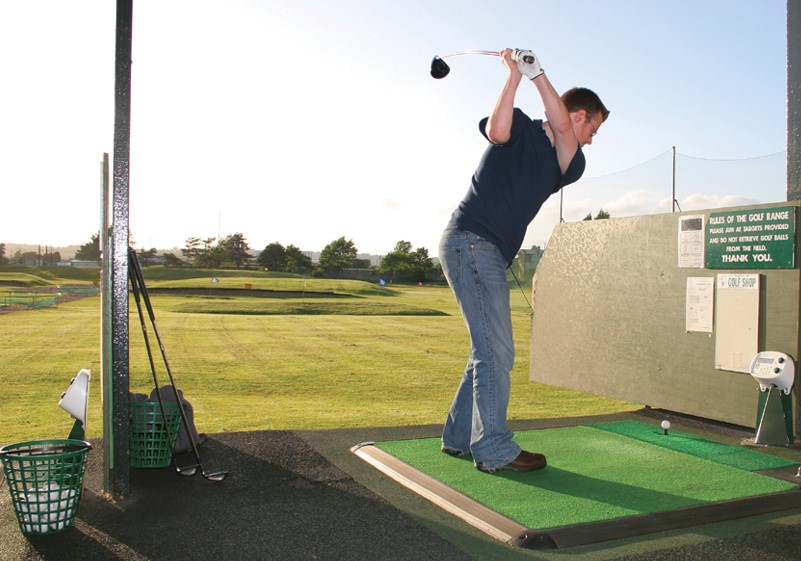
Hey, golfers. Listen up!
Usually this column is directed at your course superintendent, probably the most underappreciated person at your club. But now I’m talking to you, the golfer, about how to make the most of your club’s practice range, because:
- I don’t think you want to get hurt
- I do think you want to play a little better and have more fun on the course.
There are also some ideas in here for the superintendent, but trust me, they’re smart enough to figure out what I’m trying to say.
Driving ranges and short-game practice areas have become much more than just places to hit balls. At many clubs, they’re now social centers, where people talk and drink, give advice and give the needle, and hang out. But just because practice areas are more relaxed and more fun, doesn’t mean you shouldn’t follow a few basic rules. So please, for your sake and your superintendent’s, be smart and considerate of others.
Start with the turf. If your club or course has put down plastic practice mats, it’s for a reason: To protect the turf. Mats especially help the turf coming in and out of dormancy early and late in the season. If you ignore the mats and insist on hitting off the turf, you’re only making it more likely the turf won’t be there later.
There’s another reason to use mats when they’re laid out: To protect yourself. Moving just a few feet forward makes it more likely that you’re going to get hit — and hit hard — by someone else’s errant shot. And be real. How many sideways and other wayward shots have you seen from your buddies on the range? Harry’s screaming shank might be hilarious when you’re playing against him on the course, but when it smacks you in the ankle, chest, head or some other important body part, you won’t be laughing.
So, if the mats are there, don’t stand in front of them. And if you do, I hope the guys in the pro shop or other staff members have the guts to call you on it. It’s dangerous and stupid.
Something else about mats. It’s very likely they’re actually good for you, taking pressure off your knees, wrists and back as you hit hundreds of balls.
If the club staff is on the ball, they’ll move the mats around during the week, turning them, changing their positions and so on, to distribute the foot/club wear and tear.
Speaking of moving around, you shouldn’t keep returning to the same spot on the range. Notice how the better players at the club stand at different spots to work on different shots, like deliberate draws and fades. Also notice — and this is important — that they’re actually working on things, not just aimlessly hitting balls.
Another way you can take care of the practice area is by trying to keep your strikes and divots uniform and close together. Someone else is going to take your spot next and would like to have enough undamaged area to hit from. Trying to keep your scrapes and gouges uniform also might help you concentrate on making better contact. Really.
Working in the practice bunker? Please leave it in better shape than you found it. When you’re done, rake footprints — yours, other (less considerate) golfers’ and those made by any critters. Raking the practice bunker is also good training for raking bunkers on the course.
Hitting pitch shots and chips? If there’s a bucket of balls for your use, collect them when you’re done. This is a favor for the next golfer who comes along as well as the grounds staff. And if you’re allowed to practice short game shots on the main putting green, repair your ball marks —just as I know you’re doing on the course. And don’t leave balls scattered all over the practice green. Put them back in the bucket or collected in a spot along the edge. Practicing etiquette and courtesy is as important as practicing your stroke.
When I was a kid going to the course with my dad, he’d look up and down the practice range and say, “All those guys are doing is perfecting their flaws.” So, here’s one more way to make smart use of practice areas: Use them to take a lesson from your pro. And be sure to ask him the best way to work on what you learned the next time you’re at the range.

Explore the February 2019 Issue
Check out more from this issue and find your next story to read.
Latest from Golf Course Industry
- From the publisher’s pen: Conscientious of a bigger role
- Bernhard and Company partners with Laguna Golf Phuket
- Terre Blanche showcases environmental stewardship
- VIDEO: Introducing our December issue
- Bernhard and Company introduces Soil Scout
- Nu-Pipe donates to GCSAA Foundation’s Centennial Campaign
- GCSAA enhances golf course BMP tool
- Melrose leadership programs sending 18 to 2026 GCSAA Conference and Trade Show





